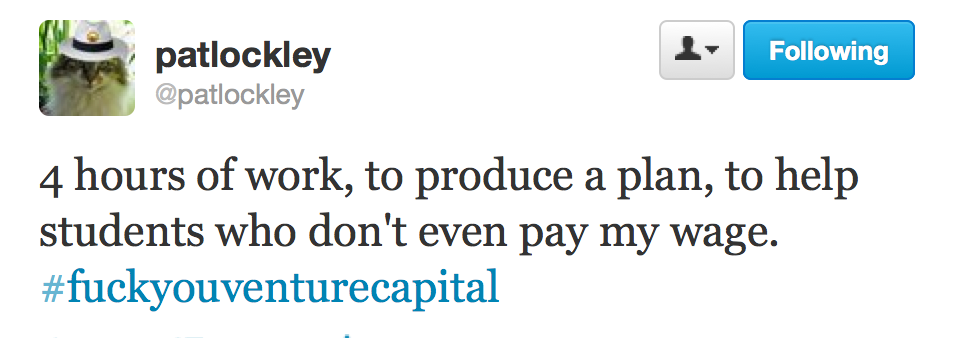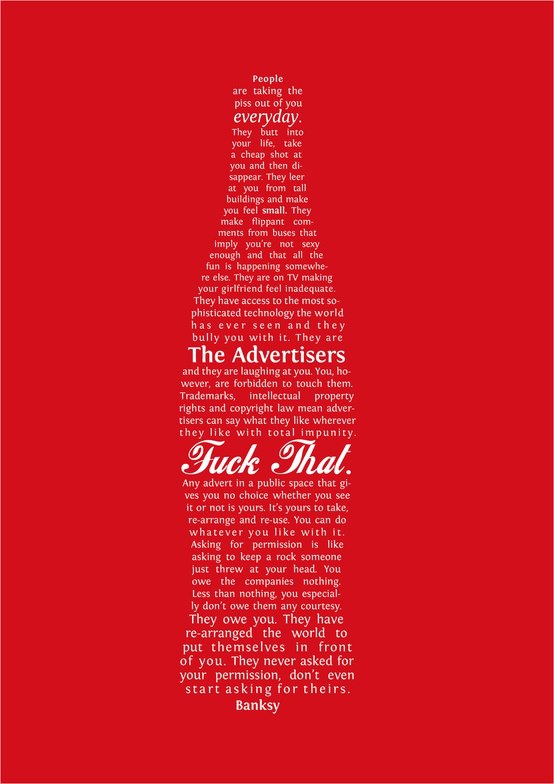
Closed until further notice shared CC by simon.hucko
I may not get a lot of readers here in my cozy little lovenest of ed tech subversion, but I couldn’t ask for a better class of visitor to drop by… Witness the comments I received on my most recent missive. Affirmation from the Bava, an offer of assistance from D’Arcy, thoughtful feedback and kind words from a UBC Philosophy prof (who is killing it with a series of #etmooc-inspired posts lately), humbling bordering on embarrassing praise from a longtime friend and mentor, and over on Twitter even some acknowledgment of that RSS Wake I was moaning about…
But my favorite comment in ages was posted by Pat Lockley, an excerpt of which reads…
Would perchance offer, as one galivants out the door like a behankerchiefed Georgian Cad, the suggestion that the open web is but an ether of both space and intoxication with which to sedate ourselves from the true hope, which may be, the democratic development of software
A suggestion that carries a little extra whiff of perfumery in the wake of Google Reader being shuttered, the category of “open like Android open” is worth thinking about. If I understand Pat correctly, he is also making a broader point that what qualifies as the “open web” may well not be building the commons. Something like the distinction between “cost-free” and “open”, and the dangers of mixing those things together.
Before I move on, I would be remiss if I didn’t offer a shout-out for the truly impressive set of WordPress plugins that Pat has developed and openly released, many of them directly focused on enhancing the capacity of highly usable open source software to support open education. If you haven’t checked them out, do so. The dude walks the talk.
The notion of ‘free but not open’ is one I have poked at before, perhaps most substantively in an article I co-wrote with Jim nearly three years ago. We argued that educators’ needs could never be a real consideration in the evolution of corporate Web 2.0. More troubling, we suggested was that the dependence on “free” Web 2.0 tools further entrenched the pre-eminence of advertising as the defining principle for a whole set of social interactions.
I don’t have a whole lot to add to that now, except that nothing has changed since then to allay those concerns.
Which brings me to a video entitled Memorex, posted by Smash TV:
Digging up long forgotten memories for a generation who spent their formative years glued to the boob tube, Memorex is a veritable nostalgia nuke for children of the 80s. Endless beach parties, Saturday morning cartoons, claymation everything, sleek cars, sexy babes, toys you forgot existed, station idents, primitive computer animation, all your favorite sugary cereal mascots, and so much more. An ode to the hyper consumerism and sleek veneer of a simpler time.
Memorex from Smash TV on Vimeo.
“A tribute to an entire generation who grew up with only a TV and a VCR for a babysitter”. Watching this video, I’m unnerved at how much of this cultural detritus is familiar. I suspect that many North Americans of… umm… a certain age will experience something similar if they watch it. People of my generation grew up immersed in this aesthetic.
Yet as I entered what passes for adulthood, I remember harbouring a fierce antipathy to advertising, fed by exemplars of the time such Negativland and Bill Hicks, Adbusters and culture jamming. The sentiment was not limited to nihilistic undergrads, a wider anti-marketing sentiment was in the air in the early 1990’s, as ably described in the first chapter of Naomi Klein’s No Logo:
The bargain craze of the early nineties shook the name brands to their core. Suddenly it seemed smarter to put resources into price reductions and other incentives than into fabulously expensive ad campaigns. This ambivalence began to be reflected in the amounts companies were willing to pay for so-called brand-enhancing advertising. Then, in 1991, it happened: overall advertising spending actually went down by 5.5 percent for the top 100 brands. It was the first interruption in the steady increase of U.S. ad expenditures since a tiny dip of 0.6 percent in 1970, and the largest drop in four decades.
…Around the same time as Marlboro Friday, the ad industry felt so under siege that market researcher Jack Myers published Adbashing: Surviving the Attacks on Advertising, a book-length call to arms against everyone from supermarket cashiers handing out coupons for canned peas to legislators contemplating a new tax on ads. “We, as an industry, must recognize that adbashing is a threat to capitalism, to a free press, to our basic forms of entertainment, and to the future of our children,” he wrote.
Despite these fighting words, most market watchers remained convinced that the heyday of the value-added brand had come and gone. The eighties had gone in for brands and hoity-toity designer labels, reasoned David Scotland, European director of Hiram Walker. The nineties would clearly be all about value. “A few years ago,” he observed, “it might have been considered smart to wear a shirt with a designer’s logo embroidered on the pocket; frankly, it now seems a bit naff.”
I realize I must sound like a baby boomer nostalgic for the glory days of Woodstock, but thinking about our acceptance of marketing and advertising infiltrating our daily lives today, the contrast in values with that era is striking. I wonder how much of our current complacency results from the Devil’s bargain we’ve made for access to “free” tools that Google, Facebook, et al… provide us. The techniques are more subtle than those on display in the Memorex video, but the implications run deeper. Certainly, it’s hard to argue against the notion that the most prominent instances of digital innovation these days are driven by marketing. And as the wheels come off of what was once quaintly described as “civil society”, these values are increasingly the models for reform of education.
A recent statement on the advertized life, one attributed to an artist who reminds me of the early 1990’s, Banksy:
Title of this post is a riff off of Pat’s “behankerchiefed Georgian Cad”, and the title of an episode from Mr. Show… itself another bit of 1990’s satire on marketing:


We’ve got a lot to learn from adbusters.
The language of education reform is now so prevalent that our only option is to undermine and parody it. We’ve got the tools and the skills and the contacts to make it so it is impossible to say “disruption” or “education is broken” or anything else in that vein without derisive mocking laughter.
We’ve got to break the spell of that narrative (and this may be the most important thing we are doing.
Thanks for another great post, Brian. Hits it right on. I have often thought I’m okay with the bargain of getting apps for free while giving away my data, because, after all, I didn’t mind having ads fired at me–I could just ignore them. And of course these things have to be paid for somehow, so I thought it was a pretty good deal: I get stuff for free, and they send me ads I ignore.
But in so doing I have also been ignoring the more insidious aspects of advertising–things that gave me reason to dislike it so much than while an undergrad I criticized a then-boyfriend relentlessly for going into advertising. Things that the Banksy work (excellent–thanks for that) and Naomi Kline point out. It’s as if I’ve just gotten used to it all and forgotten what pissed me off in the first place. So I think I fell victim to the sort of thing you note in this post–being complacent because it just became so ubiquitous. That’s ridiculous, of course, and goes against my self-image as a critical, reflective philosopher.
That’s why it’s good to have other people knock you about the head sometimes. Thanks for that.
a few things strike me about that video (I made myself watch the whole thing).
1. holy crap. I’d forgotten how ugly and boxy the 80s were. ouch. and my god. the hair. it was so big.
2. a razor with 2 blades? what kind of witchcraft is this?
3. the video feels like someone with an advertising-as-culture fetish found an archive of 80s-era ads and decided to make a mixtape. Some of it is cleverly done (the series of John Ritter punches was impressive, and the saxophone seriies, the eyeball-closeup series, sunglasses series, etc… someone did an impressive job of logging segments so they could be sequenced.) It’s definitely stilted toward advertising, rather than a more robust “this was the 80s” ethnographic thing. I mean. Seriously. Someone that puts together a 50 minute montage with probably 5000 different clips in it, and over 95% of them are ads?
4. I wonder if the emphasis on advertising was deliberate (“hey! I remember all of these awesome ads from when I was a kid! I should make something to represent my childhood using those ads, because that’s the best way to do it!” vs. “I’m so ironic and hip, I can copy and paste these clips together and it will be awesome and ironic. If only I could find a way to edit this video on my 1936 Remington Portable Typewriter at the local coffee shop, after riding there on my penny farthing and waxing my handlebar moustache.”
5. holy crap cindy crawford must be a cyborg because she hasn’t aged since 1988.
6. brooke shields looked old in 1988, though.
7. I tweeted this in response to a comment by Bonnie after the disastrously horrible Samsung S4 launch event: “marketing is about bypassing thinking. Stereotypes do that wonderfully.” this video just reinforces that – same crap in the 80s as we see today, but with crappier graphics and cheesier music. if that’s even possible.
8. the doublemint twins starting the series of people pulling food out of their mouths? creepy. were they trying to reverse the video to plant a message about rejecting advertising and corporate messaging? probably not. the hipster probably just chuckled into his fanta while editing and thought it would be extra-ironic.
9. the catfood-gag-McRibs transition was actually kind of clever.
10. I can’t believe I watched the whole thing.
11. I was struck by how many “creative” franchises are still running – many of the characters and shows are still going, with grittier rebooted incarnations. are we that creatively bankrupt? is this such a biased sample that it exaggerates this repetition? is there something fundamental or memetic about these characters or archetypes? will that pretentious dick ever be able to stop using big words?
12. I miss John Candy.
so. yeah. it was a crappy montage of crappy ads, put together in an attempt to be ironic and hip. it’s not how I remember the 80s (well, parts of it are there, but for me the 80s were about working my ass off in high school so I could get into university, and then nearly flunking out. good times. and something about the olympics. wait. am I allowed to use that word? crap. sorry if I bring down the Global Amateur Sport Event police.)